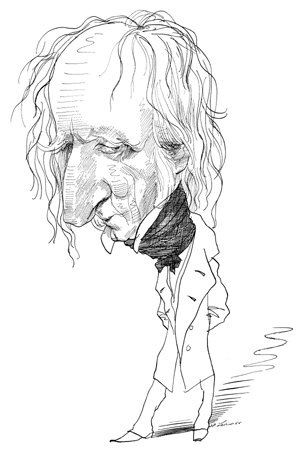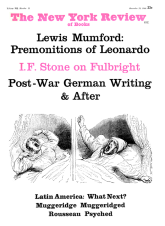“Notes are often necessary, but they are necessary evils.” Samuel Johnson’s rueful comment on his own heavily annotated edition of Shakespeare applies with an even greater force to any cradle-to-grave biography of an author. Unfortunately we cannot do without such aids to understanding. Faced with the six hundred pages of Mrs. Moorman’s sequel to her William Wordsworth: The Early Years (which also ran to over six hundred pages) the stoutest devotee’s heart is bound to quail a bit—especially as the special pleading of such recent critics as Edith Batho and John Jones has failed to convince most of us that Shelley and Arnold were wrong in thinking that after 1807 or so the poems get duller and duller. Still this dullness, even among the Ecclesiastical Sonnets, is a matter of degree. The fact is that Wordsworth, if he is to be taken at all, must be taken in toto. This child was the father of the man—and the dullard was also the son of the genius. Both of Mrs. Moorman’s volumes are therefore indispensable, if only as extraordinarily comprehensive and reliable works of reference. Here are more facts about Wordsworth the man—who was also, though the coincidence sometimes strains our credulity, Wordsworth the poet—than have ever been packed before into a biography of him. And, since Wordsworth was the most autobiographical of English poets, facts about his daily life are what we need most of all to respond properly to what Keats, embellishing a phrase of Hazlitt’s, called his “egotistical sublime.”
Twenty years ago, in the heyday of what was then the New Criticism, the critical commonplaces I have summarized in the preceding paragraph would have been dismissed as a gross case of the Biographical Fallacy. In those far-off days a poem’s meaning was presumed enclosed, like a snail in its shell, “inside” the poem. I still remember with embarrassment the public rebuke I once received from T.S. Eliot himself—it was a very public rebuke indeed, as it was delivered through a loud-speaker in the enormous football stadium of the University of Minnesota—because I had argued that, if (as seems certain) the Lucy of Wordsworth’s Lucy poems is in some sense his sister Dorothy, a quasi-incestuous relationship is necessarily implied.
ELIOT’S REBUKE, as it was eventually published (in a less offensive form) in On Poetry and Poets, concluded: “I feel no need for any light upon the Lucy poems beyond the radiance shed by the poems themselves.” What he meant was that the biographical background to the poems was “not relevant to our understanding of the poetry as poetry.” The crux however of the Lucy poems—as of The Prelude, the “Tintern Abbey” lines, the poem about the leech-gatherer (“Resolution and Independence”), and most of Wordsworth’s best poetry—is the poetical substance, as it were, of the “I” in them. If this first person singular does not refer to Wordsworth himself, as it must do in The Prelude, for example, who is the speaker? A “persona” or pseudo-Wordsworth? It is difficult however to read the Lucy poems as a group as a sort of dramatic monologue à la Browning. Eliot’s doctrine of “the poetry as poetry”—which I take to be our old friend la poésie pure in a new dress—won’t really work with Wordsworth. The presumption is that Lucy’s lover is in a certain sense Wordsworth himself, though Lucy obviously can’t be a literal transcription of Dorothy Wordsworth. After all Dorothy was very much alive when the poems bemoaning her (presumably) metaphorical death were being written. If she was dead to Wordsworth, as I am inclined to think she was, then it was in some special, private, subjective sense.
A poet for whom, when his writing is at its most moving, subjective experiences or attitudes tend to present themselves as solid objective facts, naturally creates special difficulties for the conscientious biographer. Wordsworth is not perhaps quite in the category of Smart of Blake, but he approaches it more than is usually realized. Nothing that he reports about himself can ever be taken quite at its face value. In his case, especially for the “later years” Mrs. Moorman has now reached, there is no shortage of reliable external evidence. We know where he was on almost every single day in this second part of his life, who he talked to or refused to talk to, what his annual income was (it went up by over £400 when he became the official Distributor of Stamps for Westmoreland), what clothes he wore, his predilection for legs of lamb (“lived on legs, you may almost say,” according to his butcher), his preference for wearing his hair long, and so on. But for so subjective a writer, one so dependent in everything he said and did on the spontaneous overflow of powerful feelings, the externalities of time and place have less than their normal interest and importance. This, we sense, is not the real Wordsworth.
Advertisement
ONE THING IS AT LAST becoming increasingly clear about the real Wordsworth: Like most of the other English Romantics he was not “respectable,” though his family and their descendants have done their strenuous best by deletion and destruction to thrust a Victorian respectability upon him. The official biography—Memoirs of William Wordsworth, Poet-Laureate, D.C.L.—was the work of his nephew Christopher, who later rose to be Bishop of Lincoln. The one point of interest today in this dreary compilation—apart from the Wordsworthiana it released, such as the revealing Autobiographical Memoranda on his childhood he dictated in 1847 and the notes on the separate poems, also dictated, that Isabella Fenwick took down in 1842—is the dark hints it throws out of the temptations that would beset a young man in France at the time of the Revolution. It is clear that Christopher Wordsworth was expecting a public revelation of the liaison with Annette Vallon in 1792. Poor Caroline, the wages of that sin (she married a pawnbroker), was still alive, and the scandal was well known in the Coleridge and Southey families. Mrs. Moorman also cites a letter of Christopher’s (which she dates 1857, a slip apparently for 1850) in which he says that the appalling episode had been mentioned to him casually in the street. In fact, of course, Wordsworth’s indiscretion was not made public until 1921 in George McLean Harper’s Wordsworth’s French Daughter, when paradoxically the revelation did much to rehabilitate Wordsworth with the poetry-reading public.
Mrs. Moorman’s Life is a great improvement both upon Christopher Wordsworth and upon Harper, whose two volumes of 1916 overwork the “Lost Leader” theme in a ponderous prose unworthy of a Princeton professor. But, though Mrs. Moorman’s industry, general accuracy, and good if rather old-fashioned English cannot be denied, it is a great pity she is so anxious to demonstrate how nice a person Daddy Wordsworth, as FitzGerald used to call him, always and invariably was. This new “nice” Wordsworth is uncomfortably close to the Victorian “respectable” Wordsworth. It is perhaps not an accident that her husband is now the Bishop of Ripon, or that her own father (G.M. Trevelyan, the historian) was once the Master of Trinity College, Cambridge. Christopher Wordsworth, besides being a bishop, was also the offspring of a Master of Trinity—Wordsworth’s youngest brother, who was irreverently called “meeserable offenders” by undergraduates like Tennyson and Thackeray because of the northern vowels with which he intoned the General Confession in Trinity Chapel. I admit I would have liked more of the “meeserable offenders” approach to Wordsworth himself in Mrs. Moorman. If he was a genius he was also and pre-eminently an oddity, especially in those “later years.”
I REGRET IN PARTICULAR that Mrs. Moorman makes so little use of Rawnsley’s classic “reminiscences of Wordsworth among the Peasantry of Westmoreland,” a paper originally read to the Wordsworth Society in 1882 with Browning in the chair. Wordsworth’s peasant neighbors were splendidly uninhibited in their recollections of him. “He was a ugly-faaced man, and a mean liver.” “He never cared for children, however; ya may be certain of that, for didn’t I have to pass him four times in’t week, up to the door wi’ meat? And he niver oncst said owt.” “He wozn’t a man as said a deal to common folk. But he talked a deal to hissen. I often seead his lips a gaain’, and he’d a deal o’ mumblin’ to hissel, and ‘up stop short and be a lookin’ down upo’ the ground, as if he was in a thinkin’ waay. But that might ha’ growed on him wi’ age, an’ aw, ye kna.” Si sic omnia.
For Mrs. Moorman the “later years” begin in December 1803, when Wordsworth was in fact only thirty-three, though he is said to have looked much older. A more appropriate division might have been in October 1802 when he married—or was married by—his dull “phantom of delight,” Mary Hutchinson. (A canceled passage in Dorothy Wordsworth’s Journal that is not mentioned in either of Mrs. Moorman’s volumes records that it was she who wore the wedding ring throughout the previous night.) Dorothy also accompanied the bride and bridegroom on their curious honeymoon. But Mrs. Moorman is not particularly interested in Dorothy. The center of interest in this volume is the relationship with Coleridge, and much the most dramatic chapter, distressing though it is to read is that entitled. “The Estrangement, 1810-1813.” Inevitably perhaps Mrs. Moorman’s sympathies are all with Wordsworth, who had certainly a lot to put up with from Coleridge’s alcoholism and drug-addiction, the neurotic jealousy (Sara Hutchinson, with whom Coleridge was deeply in love, sometimes gave the impression of preferring Wordsworth), the perpetual procrastinations, and the often maudlin selfpity. Nevertheless, at a deeper level, it is impossible not to feel that in the end it is Coleridge who emerges with least discredit from the imbroglio. Coleridge after all was about to write his Biographia Literaria, the most brilliant and perceptive account of Wordsworth’s poetry in existence. But when the book came out Wordsworth could only bring himself to skim it quickly and unfavorably. It is hard to forgive such totally complacent self-righteousness.
Advertisement
WILL WORDSWORTH LAST? Mrs. Moorman naturally has no doubts about it and scatters eulogies among the poems with an optimistic, over-generous hand. But the old assumption that he is Number Three in the English poetical order of merit is beginning to wear decidedly thin. If his poetry is manifestly inferior to that of Shakespeare and Milton, is it so obviously better than Chaucer’s, Donne’s, Blake’s, and Keats’s? And, coming down to individual poems, “The Ancient Mariner” and “Kubla Khan” are unquestionably demonstrating a staying power denied, for example, to “Intimations of Immortality.” Douglas Bush gave it as his opinion in a lecture on the centenary of Wordsworth’s death that he was “not an active force in our time” outside the universities. I am inclined to agree with him.
But the academic exception is certainly a fact. For reasons I don’t profess to understand, university theses on one or other aspect of Wordsworth have multiplied recently almost ad nauseum. Christopher Salvesen’s The Landscape of Memory is one of the very few theses I have met that has outgrown the limitations of the genre. His subject is the “emotion recollected in tranquility” that Wordsworth defined in a familiar passage as poetry’s point of origin, which he illustrates from Wordsworth’s own poetry. The argument is not always easy to follow, but for those who are on the look-out for a subtle and perceptive introduction to this peculiarly Wordsworthian poetry of memory this is the book. I wish I could be certain that the poems themselves are as good “as poetry” as they are idiosyncratic.
This Issue
December 29, 1966




